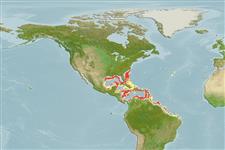Common names from other countries
Elasmobranchii (haaien en roggen) (sharks and rays) >
Rajiformes (Skates and rays) >
Rajidae (Skates)
Etymology: Dipturus: Greek, di = two + Greek, pteryx = fin (Ref. 45335).
Environment: milieu / climate zone / depth range / distribution range
Ecologie
marien bathydemersaal; diepte 310 - 1900 m (Ref. 114953). Deep-water; 35°N - 4°S, 97°W - 35°W (Ref. 114953)
Western Atlantic: North Carolina (Ref. 114953), off Florida (Ref. 12965, 13608) including Gulf of Mexico (Ref. 114953) to northern coast of Colombia, and off Suriname (Ref. 13608 and Brazil (Ref. 53436)
Grootte / Gewicht / Leeftijd
Maturity: Lm ? range ? - ? cm
Max length : 84.0 cm TL mannelijk / geslacht onbekend; (Ref. 114953)
Lack of thorns along the midbelt of the disc from the level of the axils of the pectoral fins to the vicinity of the spiracles. Tails widen rearward toward the dorsal fins. No interspace between the bases of the dorsal fins. Upper surface pale brown, darker along posterior margins of disc, pelvic fins and tail. Dorsal fins and caudal black. Lower surface margined with black rearward from the level of the mouth (Ref. 6902).
Found on upper continental slope (Ref. 114953). Oviparous (Ref. 50449). Eggs have horn-like projections on the shell (Ref. 205). Males reaches maturity at ca.63 cm TL (Ref. 114953).
Levenscyclus en paargedrag
Maturities | Voortplanting | Spawnings | Egg(s) | Fecundities | Larven
Oviparous, paired eggs are laid. Embryos feed solely on yolk (Ref. 50449).
McEachran, J.D. and K.A. Dunn, 1998. Phylogenetic analysis of skates, a morphologically conservative clade of elasmobranchs (Chondrichthyes: Rajidae). Copeia 1998(2):271-290. (Ref. 27314)
Status op de Rode Lijst van het IUCN (Ref. 130435)
CITES (Ref. 128078)
Not Evaluated
Gevaar voor de mens
Harmless
Gebruik door de mens
Visserij: van minder commercieel belang
Tools
Speciale rapporten
Download XML
Internetbronnen
Estimates based on models
Preferred temperature (Ref.
115969): 7 - 15, mean 10.1 (based on 115 cells).
Fylogenetische diversiteitsindex (Ref.
82804): PD
50 = 0.5000 [Uniqueness, from 0.5 = low to 2.0 = high].
Bayesian length-weight: a=0.00282 (0.00133 - 0.00596), b=3.25 (3.08 - 3.42), in cm Total Length, based on LWR estimates for this Genus-body shape (Ref.
93245).
Trofisch niveau (Ref.
69278): 3.8 ±0.6 se; based on size and trophs of closest relatives
Weerstandsvermogen (Ref.
120179): laag, minimale populatieverdubbelingstijd 4,5-14 jaar (Fec assumed to be <100).
Fishing Vulnerability (Ref.
59153): Moderate to high vulnerability (54 of 100).
